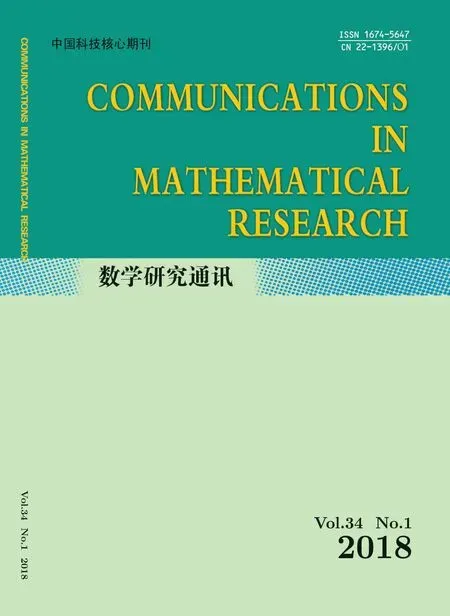Growth of Solutions of Some Linear Difference Equations with Meromorphic Coefficients
TU HONG-QIANG AND LIU HUI-FANG
(College of Mathematics and Information Science,Jiangxi Normal University,Nanchang,330022)
Communicated by Ji You-qing
1 Introduction and Main Results

Nevanlinna’s theory has been widely applied to the field of complex difference.Many researchers studied the properties of meromorphic solutions of the following linear difference equation by this theory

wheren∈N,cj(j=1,···,n)are nonzero complex numbers which are different from each other,and obtained lots of results concerning the growth and value distribution of meromorphic solutions of(1.1)(see[3]–[9]).Therein Chiang and Feng[4]considered thecase when there is only one dominating coefficient among all entire coefficients of(1.1),and obtained the following result:
Theorem A[4]Let A0(z),···,An(z)be entire functions.If there exists an integer l(0≤l≤n)such that



When most coefficients of(1.1)have the same order,Qiet al.[9]studied the properties of meromorphic solutions of the following linear difference equation

and obtained the following results:
Theorem B[9]Let Pj(z)and Qj(z)(j=0,1,···,n?1)be polynomials,A(z)be a polynomial of degree k(≥1).If

then each nontrivial meromorphic solution f(z)with finite order of(1.2)satisfies

and so f assumes every nonzero complex value a∈Cinfinitely often.
Theorem C[9]Suppose that the assumptions of Theorem B are satisfied.If f(z)is a nontrivial entire solution with finite order of(1.2)that satisfies λ(f)≤k,then σ(f)=k+1.
Comparing Theorem A with Theorem B and Theorem C,we pose the following questions:

Question 1.2Theorem C provided a criterion which guarantee that each entire solution of(1.2)has the smallest order.Then under the assumptions of Question 1.1,what else condition can guarantee that each meromorphic solution of(1.1)has the smallest order?
In this paper,we investigate the above questions and obtain the following results.



Considering the non-homogeneous linear difference equation

we obtain the following result.
Theorem 1.3Let Aj(z)(j=0,1,···,n)and l satisfy the conditions of Theorem1.1,and let F(z)(/≡0)be a meromorphic function with σ(F)<k+1.Then each meromorphic solution f(z)with finite order of(1.3)satisfies λ(f)=σ(f)≥k+1with at most one possible exceptional solution f0satisfying σ(f0)<k+1.
2 Lemmas
We need the following lemmas for the proof of the above theorems.


Lemma 2.2[10]Let f(z)be a non-constant meromorphic function.Then for all irreducible rational functions in f

with meromorphic coefficients ai(z),bj(z)(i=0,···,p,j=0,···,q),we have

Lemma 2.3[10]Let g:[0,+∞)→R,h:[0,+∞)→Rbe monotone increasing functions such that g(r)≤h(r)outside of an exceptional set E of finite logarithmic measure.Then,for any α>1,there exists an r0>0such that g(r)≤h(αr)holds for all r>r0.
Lemma 2.4[11]Let fj(z)(j=1,···,n+1,n≥2)be meromorphic functions,gj(z)(j=1,···,n)be entire functions,and satisfy

(ii)when1≤j<k≤n,gj(z)?gk(z)is not a constant;
(iii)when1≤j≤n+1,1≤h<k≤n,

where E?(1,∞)is of finite linear measure or finite logarithmic measure.
Then fj(z)≡0(j=1,···,n+1).
Lemma 2.5[12]Let f(z)be a meromorphic function of order σ(f)=σ<∞.Then for any given ε>0,there exists a set E?(1,∞)of finite linear measure such that for all|z|=r/∈[0,1]∪E,and r sufficiently large,we have

Lemma 2.6[4]Let f be a non-constant meromorphic function with finite order,and η be a nonzero complex number.Then for each ε>0,we have

Lemma 2.7Let Aj(j=0,···,n)be meromorphic functions,and f(/≡0)be a meromorphic solution with finite order of the difference equation





whered1(z)andd2(z)respectively are the canonical products(or polynomials)formed by zeros or poles off(z),such that

andh(z)is a polynomial.By(2.2)and(2.3),we get

Substituting(2.2)into(2.1),we get

By Lemma 2.6 and(2.3)–(2.5),we get

On the other hand,by(2.5),we get

Thus,by(2.7)and(2.8),we get

Then by Lemma 2.4,(2.6),(2.8)and(2.9),we get

This is a contradiction.Lemma 2.7 is thus proved.
Lemma 2.8[8]Let f(z)be a meromorphic solution with finite order of(1.3).If

then λ(f)=σ(f).
3 Proofs of Results
3.1 Proof of Theorem 1.1
Suppose that





Now we discuss the following two cases.





By(3.6)and Lemma 2.3,we getk≤σ?1+ε,which impliesσ(f)=σ≥k+1.
Case 2.If deg(Ql)>deg(Qj)(j=0,1,···,n,j/=l),then we take a suitablezsuch that|z|=randakzk=?|ak|rk.By the similar method as in the proof of Case 1,we can obtainσ(f)≥k+1.
In the following,we prove thatλ(f?φ)=σ(f).
Setg(z)=f(z)?φ(z).Substitutingf(z)=g(z)+φ(z)into(1.1),we obtain

IfH(z)≡0,thenφ(z)is a nonzero meromorphic solution of(1.1).Thus,by the above proof,we get

This is absurd.Hence,

On the other hand,by Lemma 2.2,we get

Since eAis of the regular growth,by(3.9),we getT(r,Aj)=(pj+qj)T(r,eA)+S(r,eA)(j=0,···,n).Hence we get

Then by(3.10)and Lemma 2.6,we get

So by Lemma 2.8,(3.7),(3.8),(3.10)and(3.11),we obtain

Theorem 1.1 is thus proved.
3.2 Proof of Theorem 1.2

Suppose thatσ(f)>k+1.By(3.10)we get

Then combining with Lemma 2.7 and(3.13),we get

This contradicts the hypothesis of Theorem 1.2.Hence we getσ(f)=k+1.Theorem 1.2 is thus proved.
3.3 Proof of Theorem 1.3


andf??f0is a solution of the corresponding homogeneous equation(1.1)to(1.3).By Theorem 1.1,we have

a contradiction.Hence(1.3)possesses at most one exceptional solutionf0withσ(f0)<k+1.
Now Suppose thatfis a meromorphic solution of(1.3)withk+1≤σ(f)<∞.Combining(3.10),we have

Hence,by Lemma 2.8,we get

Theorem 1.3 is thus proved.
[1]Hayman W.Meromorphic Functions.Oxford:Clarendon Press,1964.
[2]Yang L.Value Distribution Theory and Its New Research.Berlin:Springer-Verlag,1993.
[3]Halburd R G,Korhonen R J.Difference analogue of the lemma on the logarithmic derivative with applications to difference equations.J.Math.Anal.Appl.,2006,314:477–487.
[4]Chiang Y M,Feng S J.On the Nevanlinna characteristic off(z+η)and difference equations in the complex plane.Ramanujan J.,2008,16:105–129.
[5]Laine I,Yang C C.Clunie theorems for difference andq-difference polynomials.J.Lond.Math.Soc.,2007,76(2):556–566.
[6]Chen Z X.Growth and zeros of meromorphic solution of some linear difference equations.J.Math.Anal.Appl.,2011,373:235–241.
[7]Chen Z X.Zeros of entire solutions to complex linear difference equations.Acta Math.Sci.Ser.B Engl.Ed.,2012,32(3):1141–1148.
[8]Liu Y X.On growth of meromorphic solutions for linear difference equations with meromorphic cofficients.Adv.Difference Equ.,2013,2013:60,9pp.
[9]Qi X G,Liu Y,Yang L Z.The growth of the solutions of certain type of difference equations.Taiwanese J.Math.,2015,19(3):793–801.
[10]Laine I.Nevanlinna Theory and Complex Differential Equations.De Gruyter Studies in Math.,15.Berlin:Walter de Gruyter&Co.,1993.
[11]Yang C C,Yi H X.Uniqueness Theory of Meromorphic Functions.Dordrecht:Kluwer Academic Publishers Group,2003.
[12]Chen Z X,Shon K H.On the growth and fixed points of solutions of second order differential equations with Meromorphic Coefficients.Acta Math.Sin.Engl.Ser.,2005,21(4):753–764.
 Communications in Mathematical Research2018年1期
Communications in Mathematical Research2018年1期
- Communications in Mathematical Research的其它文章
- The Mod 2 Kauffman Bracket Skein Module of Thickened Torus
- Unique Common Fixed Points for Two Weakly C?-contractive Mappings on Partially Ordered 2-metric Spaces
- On the Coefficients of Several Classes of Bi-univalent Functions Defined by Convolution
- On Lie 2-bialgebras
- One Parameter Deformation of Symmetric Toda Lattice Hierarchy
- Reversible Properties of Monoid Crossed Products
